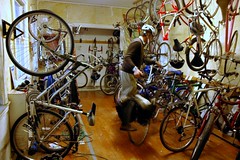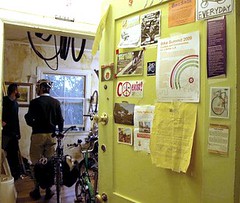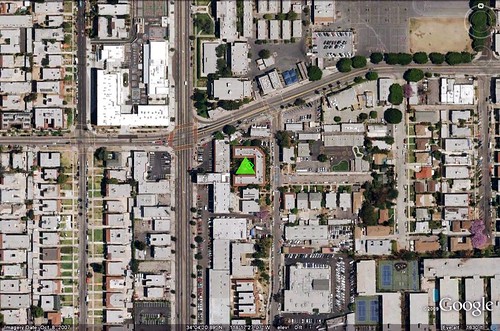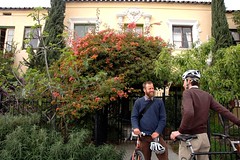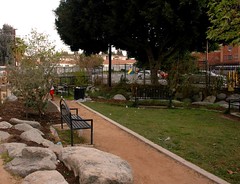LA’s Eco-Village: a venture in intentional community and sustainability

Posted April 27, 2010 at 1:33PM
Los Angeles’s Eco-Village is a two-block, 11-acre community dedicated to intentional, ‘whole-systems’ sustainable living in the heart of the city. Its area eccompasses about 500 residents in the city’s East Hollywood and Koreatown special planning districts.
From what one can see on the web, it’s quite a place, and about as far from stereotypical Los Angeles as one can get. (Of course, real LA isn’t all that close to stereotypical LA, either.) Many residents do not own cars (and receive a discount on rent for their choice), but the community does own live chickens. A good deal of space is devoted to bicycle parking. There is a lot of communal living, including potluck dinners, meetings, workshops on permaculture approaches to sustainable urban living, and work parties. The Eco-Villagers even held a retreat to create a shared vision that, according to one of its many overlapping web sites (main site here), is still in progress. There appears to be a strong anti-consumptive vibe, and nature gets a place of honor in the community’s courtyards, gardens, streets and, for that matter, hallways.
The Village registered for the LEED for Neighborhood Development pilot program, and has articlulated a series of neighborhood planning goals:
- Restoring the neighborhood’s long-forgotten but once-popular hot springs, the Bimini Baths;
- Building workforce housing (“targeted to LA [public school] teachers and staff who want to live more cooperatively and car free”) above the restored Baths;
- Establishing small green businesses and community services along one of the neighborhood’s commercial streets;
- A demonstration of geothermal district heating;
- Demonstration of a “biological living machine or eco machine that serves as a further educational facility--both beautiful and functional--to clean water for local re-use and/or clean hot waters and return to the aquifer.”
The Eco-Village was established in 1993 by the Cooperative Resources and Services Project, itself founded by Village resident and, one might say, 'godmother' Lois Arkin. CRSP’s web site explains:
“CRSP is a public-benefit non-profit established to provide educational resources for small cooperatives. The CRSP office and library have been located in the Bimini and White House Place neighborhood since 1980. The transit-rich area [note: its Walk Score is 95] is close to a Metro Redline Station, only three miles west of downtown. The two-blocks in Mid-Wilshire/Koreatown are home to a multi-ethnic working class community of about five hundred people.
“After the Civil Unrest of April, 1992, CRSP decided to put its resources to work in its own problematical neighborhood in a way that could benefit the city at large and started the Los Angeles Eco-Village demonstration project.
“CRSP currently owns the two buildings where the LA Eco-Village is located and provides funds for their basic rehabilitation and ecological retrofitting. This is done trough the Ecological Revolving Loan Fund (ELF).
“CRSP applies a whole-systems approach to community development, integrating the social, economic and physical aspects of neighborhood life to demonstrate a healthy urban community. Their plan includes converting housing from rental to permanently affordable cooperative ownership. CRSP intends for its efforts to reduce the burdens of government, while increasing local self-reliance in the areas of livelihood, food production, energy, water, transportation, recreation, waste processing and education.”
You have to wish such idealism well, I think.
While laudable, this sort of arrangement probably isn’t for everyone. To me, there seems to be a sort of early-70s, almost rural vibe to the photographs and video, with the chickens running around, shrubbery that looks like it hasn’t been trimmed since, well, ever, what appear to be stains (from water damage?) on some of the walls and so forth. If I were a neighbor, I would probably be on their case to tidy up a bit. (And it reminds me that my own early-70s neighbors were very tolerant.) But I suspect Arkin wouldn’t have it any other way, and neither would her fellow Villagers.
I’m also reminded of a small condo building I lived in back in the early 1980s. One of my fellow owner-residents was a Russian expatriate writer. When we tried to recruit him for the condo board, his eyes twinkled a bit and he said, roughly translated, “Hey, I didn’t escape one communist system just to join another. Have fun.”
I bet the Eco-Villagers do have a lot of fun. Here’s a video on the project recently produced by Streetfilms:
There are a number of other videos on the community, including this one. Arkin has written a good summary of the Village’s history here, and you can visit the project's main blog here.

